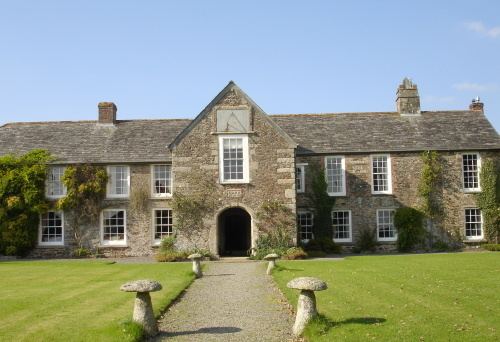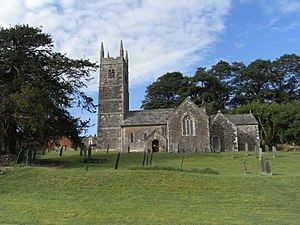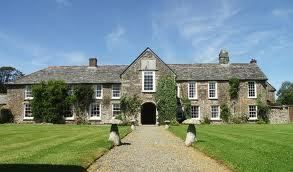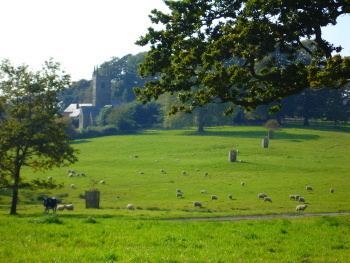 | ||
South tetcott 31 12 2011
Tetcott is a civil parish, small settlement and former manor (once the home of the Arscotts of Tetcott) in Devon, England. The parish lies about five miles south of the town of Holsworthy and is bordered on the north by the parish of Clawton, on the east by a small part of Ashwater, and on the south by Luffincott. It forms part of the local government district of Torridge, and its western boundary is the River Tamar which forms the Cornish border. In 2001 its population was 110, half that of a century earlier (220 in 1901).
Contents
- South tetcott 31 12 2011
- Blagdon manors the tetcott room
- Parish church
- Arscott of Tetcott
- Descent
- Molesworth of Tetcott
- Tetcott hunt
- References

The settlement of Tetcott itself consists almost solely of the manor house and parish church of Holy Cross, but there are other hamlets in the parish, the largest of which is Lana about half a mile to the south-east.

Blagdon manors the tetcott room
Parish church

The parish church was dedicated by the Bishop of Waterford in 1338 or 1339. Before the Reformation it was dedicated to the Trinity. In 1740 the parish feast day was said to have been 3 May (the date of the Invention of the True Cross) probably leading, according to Nicholas Orme, to its present dedication to "Holy Cross", the first record of which dates from 1742.

The present-day church has a Norman font and partly dates from the 13th century with some 16th-century additions, mainly the tower. The church was restored in 1890. It has one bell, though three are recorded in an inventory of 1553. A local tradition says that the treble bell at North Tamerton, across the River Tamar, came from Tetcott church and John Taylor the bell-founder having recast North Tamerton's ring of five in the early 19th century sold the treble to Tetcott so that the parishioners at North Tamerton could hear it across the valley and decide to acquire it.
The south transept of the church, known as the Arscott Chapel, contains an ornate pew for the family and notable pew railings dating from around 1700. There are also four memorials to members of that family, the most elaborate to John Arscott (died 1675), who was Sheriff of Devon, and his wife. The others are noted below.
Arscott of Tetcott

W. G. Hoskins described the Arscotts as one of the ancient families of freeholders that rose to the ranks of the squirearchy over a period of 300 years or so by the steady accumulation of property, mostly through marriage. Originating at Arscott (now known as South Arscott, north of the town of Holsworthy), a junior branch of the family moved to Tetcott in about 1550.
Arthur Arscott (1554–1618) built a new manor house at Tetcott in 1603, which survives today in expanded form. A new and larger house was built adjacent to it by his descendants during the reign of Queen Anne (1702–1714). At this time new outbuildings were built in brick, unusual in Devon, some of which survive. The Queen Anne style house was demolished in 1831.
Descent
Molesworth of Tetcott
Following the Arscotts, Tetcott was inherited by their distant cousins the family of Molesworth, later Molesworth-St Aubyn, of Pencarrow, Cornwall, who continue there until the present day. The 7th and 15th Molesworth-St Aubyn baronets had as a first-name "Arscott". In 1831, whilst retaining the original manor house used some time later as a farmhouse, they demolished the adjacent Queen Anne mansion, an act much resented by the local population, and built in its place a "Gothic cottage" to serve as a hunting lodge. This was burned down, apparently by disgruntled locals five years later.
In 1925, as a secondary residence to Pencarrow, the family moved into the original manor house, formerly let as a farmhouse, which survives today. It is a long two-storey building built of rubble stone. Above the round arch of the central two-storey porch was reset, in the 20th century, the 1603 datestone taken from Tetcott Mill.
Tetcott hunt
The last of the Arscotts had been a keen hunter, and kennelled his pack of hounds at Tetcott. Later the sporting rights were acquired by Vincent Calmady who in about 1872 formed a pack of otter-hounds. In 1879 he recommenced fox-hunting on the Tetcott country, and the current South Tetcott Hunt and Tetcott Hunt continue today.
HMS Tetcott a Type II British Hunt class destroyer was built for the Royal Navy during World War II, named after the hunt. In 2013 Mr Paul Martin MFH, master of the South Tetcott Hunt, lives at Tetcott.
